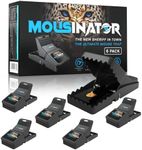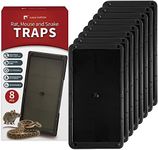Buying Guide for the Best Mouse Traps
Choosing the right mouse trap can make a big difference in how effectively and humanely you deal with unwanted rodents. There are several types of mouse traps, each with their own strengths and weaknesses. The best trap for you depends on your preferences, the severity of your mouse problem, and whether you want to catch and release or eliminate the mice. Understanding the key features of mouse traps will help you make a choice that fits your needs and your home environment.Trap TypeTrap type refers to the basic design and mechanism of the mouse trap. The main types are snap traps, electronic traps, glue traps, and live-catch traps. Snap traps are traditional and kill mice quickly, electronic traps use a high-voltage shock, glue traps immobilize mice, and live-catch traps allow you to release the mouse elsewhere. The type you choose depends on whether you prefer a quick solution, a hands-off approach, or a humane catch-and-release method. Consider your comfort level with handling mice and your ethical preferences when picking a trap type.
Ease of UseEase of use describes how simple it is to set up, bait, and empty the trap. Some traps require careful handling to avoid accidental triggering, while others are designed for quick and safe setup. If you want a hassle-free experience, look for traps that are easy to set and clean, especially if you have never used a mouse trap before. For those who want minimal contact with mice, traps with enclosed designs or easy disposal features are a good choice.
SafetySafety is about how likely the trap is to cause accidental injury to people or pets. Some traps, like traditional snap traps, can be dangerous if left in areas accessible to children or animals. Others, such as enclosed or electronic traps, are designed to minimize risk. If you have kids or pets at home, prioritize traps with safety features or those that can be placed out of reach. Always consider where you plan to set the trap and who might come into contact with it.
ReusabilityReusability refers to whether the trap can be used multiple times or is meant for single use. Some traps are disposable and should be thrown away after catching a mouse, while others can be cleaned and reset. If you expect to deal with more than one mouse, reusable traps can be more convenient and environmentally friendly. However, if you prefer not to handle used traps, single-use options might be better for you.
Humane ConsiderationsHumane considerations involve how the trap deals with the mouse. Some traps are designed to kill instantly, while others capture the mouse alive for release. If you are concerned about animal welfare, look for traps labeled as humane or live-catch. These traps allow you to release the mouse far from your home. On the other hand, if you need a quick and decisive solution, traditional or electronic traps may be more appropriate. Your personal values and the severity of your mouse problem should guide your choice here.
Size and PlacementSize and placement refer to the physical dimensions of the trap and where it can be used. Some traps are compact and fit easily in tight spaces, while others are larger and more visible. Think about where you have seen mouse activity and choose a trap that fits those areas. For small spaces like behind appliances or in cupboards, a compact trap is ideal. For open areas, a larger trap may be more effective. Matching the trap size to your available space ensures better results.
















